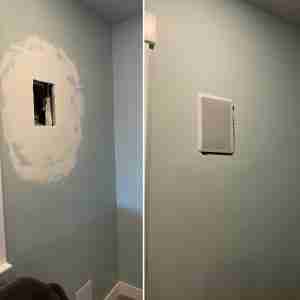Your house looks a bit dull. The bright blue walls that you get painted begin to lose their color. You decide to get your house painted and give it a fresh look. Repairing or renewing your house interior is good, but you have to check a few things before getting buckets of paint.
If you have drywall in your house, you have to check whether they need repairing. If they do, take proper steps to repair it and don’t go for ‘quick fixes’. These fixes only provide relief temporarily and you will encounter the same problem again.
If this problem exists, the purpose for which you install the drywall will remain unfulfilled. The money you spent on the paint will also go down the drain.
How to Repair Drywall
In tutorials or guides, drywall repair seems easy. But, in reality, it isn’t. It requires attention to detail and precision. Also, note that this will work on small damages only. Call a professional if the drywall needs extensive repairs.
Water Damage
If there is extensive water damage, it is best to replace the entire drywall. In case where damage is minimal, you can consider some of drywall repair techniques. Before trying to fix the wall randomly, let the wall dry. Check the wall once it is completely dried. A superficially damaged wall can easily be repaired. The mold-affected areas can be treated by an anti-mold solution. After this, apply a quality filler over the area and sand down bumps, if any. If the area is spongy and soft, you have to get it repaired.
Hairline Cracks
As the name suggests, these thin cracks appear inside corners of a wall. These can be repaired by acrylic latex caulk which is strong enough to withstand the movement between adjacent walls.
Loose Tape
One of the most common drywall damages is tape bubbling. This happens due to the improper installation of the drywall. This makes the bond between the wall and the tape weak. To repair this, what you need to do is to cut around bubbles and remove the tape. Subsequently, fill the hole with joint compound. Use sandpaper to flatten any bumps once the compound dries out.
Holes
Holes in the drywall can be a menace. They do not only provide a gateway to the wind or heat, but they also provide a passage to unwanted insects into your house. These holes can be fixed. For small holes, get spackling compound and for larger holes, get joint compound. Use a putty knife to apply the filler. Once it dries out, apply another coat. Be careful while doing and don’t overflow it. After the second layer is dried, use the sandpaper for a smooth surface. You can also use self-adhesive drywall patches to fix at least a six-inch hole. If the wall has multiple holes or when the damage is extensive, it is always better to let the professionals handle it.
Summary
The latest trend is to install the drywall in your house. It keeps your house protected from outside weather and other related things. If you experience wall damage, follow this guide to fix them.




